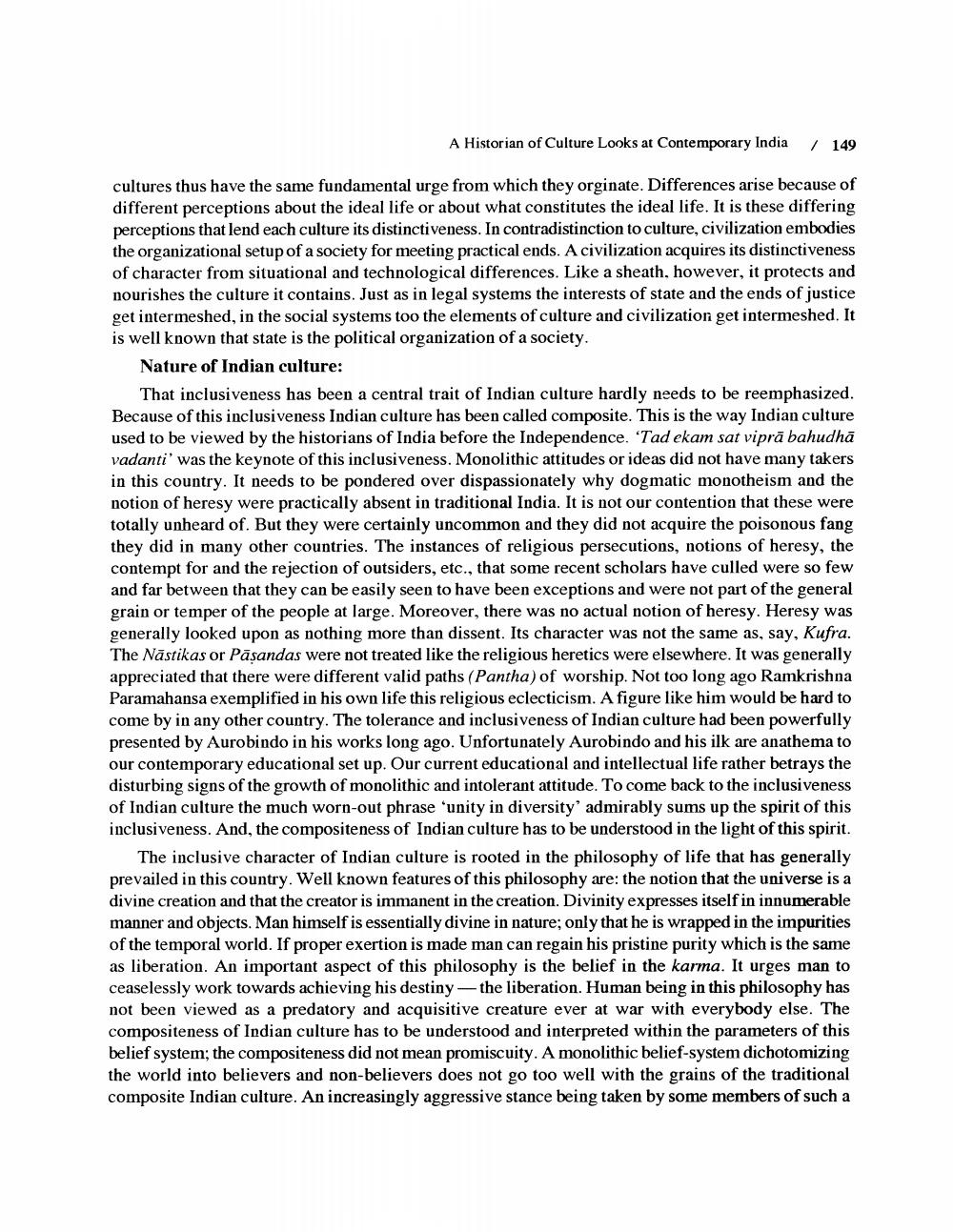________________
A Historian of Culture Looks at Contemporary India
/ 149
cultures thus have the same fundamental urge from which they orginate. Differences arise because of different perceptions about the ideal life or about what constitutes the ideal life. It is these differing perceptions that lend each culture its distinctiveness. In contradistinction to culture, civilization embodies the organizational setup of a society for meeting practical ends. A civilization acquires its distinctiveness of character from situational and technological differences. Like a sheath, however, it protects and nourishes the culture it contains. Just as in legal systems the interests of state and the ends of justice get intermeshed, in the social systems too the elements of culture and civilization get intermeshed. It is well known that state is the political organization of a society.
Nature of Indian culture:
That inclusiveness has been a central trait of Indian culture hardly needs to be reemphasized. Because of this inclusiveness Indian culture has been called composite. This is the way Indian culture used to be viewed by the historians of India before the Independence. "Tad ekam sat viprā bahudhā vadanti' was the keynote of this inclusiveness. Monolithic attitudes or ideas did not have many takers in this country. It needs to be pondered over dispassionately why dogmatic monotheism and the notion of heresy were practically absent in traditional India. It is not our contention that these were totally unheard of. But they were certainly uncommon and they did not acquire the poisonous fang they did in many other countries. The instances of religious persecutions, notions of heresy, the contempt for and the rejection of outsiders, etc., that some recent scholars have culled were so few and far between that they can be easily seen to have been exceptions and were not part of the general grain or temper of the people at large. Moreover, there was no actual notion of heresy. Heresy was generally looked upon as nothing more than dissent. Its character was not the same as, say, Kufra. The Năstikas or Pasandas were not treated like the religious heretics were elsewhere. It was generally appreciated that there were different valid paths (Pantha) of worship. Not too long ago Ramkrishna Paramahansa exemplified in his own life this religious eclecticism. A figure like him would be hard to come by in any other country. The tolerance and inclusiveness of Indian culture had been powerfully presented by Aurobindo in his works long ago. Unfortunately Aurobindo and his ilk are anathema to our contemporary educational set up. Our current educational and intellectual life rather betrays the disturbing signs of the growth of monolithic and intolerant attitude. To come back to the inclusiveness of Indian culture the much worn-out phrase 'unity in diversity' admirably sums up the spirit of this inclusiveness. And, the compositeness of Indian culture has to be understood in the light of this spirit.
The inclusive character of Indian culture is rooted in the philosophy of life that has generally prevailed in this country. Well known features of this philosophy are: the notion that the universe is a divine creation and that the creator is immanent in the creation. Divinity expresses itself in innumerable manner and objects. Man himself is essentially divine in nature; only that he is wrapped in the impurities of the temporal world. If proper exertion is made man can regain his pristine purity which is the same as liberation. An important aspect of this philosophy is the belief in the karma. It urges man to ceaselessly work towards achieving his destiny - the liberation. Human being in this philosophy has not been viewed as a predatory and acquisitive creature ever at war with everybody else. The compositeness of Indian culture has to be understood and interpreted within the parameters of this belief system; the compositeness did not mean promiscuity. A monolithic belief-system dichotomizing the world into believers and non-believers does not go too well with the grains of the traditional composite Indian culture. An increasingly aggressive stance being taken by some members of such a




